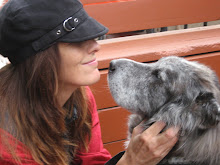


Through Zion we travel through a tunnel in the mountain. A tunnel toward Bryce. A tunnel into a time and space where beauty and peace exists.
Climbing to higher elevation soothes the soul. Cool air. Joining jagged peaks that reach to the heavens. Springtime in Bryce. Snow. Less humans and more space. Unfortunately, Dan gets a 24 hour bug and is tucked away in bed all day. I take the kids trouncing through the snow to the rim of Bryce Canyon. We are going to see the queen! The hoo-doo queen!
Hoodoo (1. a pinnacle or odd-shaped rock left standing from the forces of erosion 2. To cast a spell or bad luck)
Quick geological timeline: 200 million years ago: a clash between NA's continental crust and a strong Pacific seafloor left a shattered North America on top. For 120 millions years, the bends, folds, and compressions of this battle gave birth to the once mighty Sevier Mnts. Over time, rain and snow split them apart and rivers carried pulverized boulders and mud eastward.
65 million years ago, just before dinosaurs went extinct: Western US changes. The oceanic plate pushes up our continental crust: The Rocky Mnts are born! The basin between both mnt. ranges collects layers of mud and silt.
55-30 million years ago: a mammoth mud puddle called the Claron Basin fills with calcium carbonate: two types of dissolved limestone. A lower pink layer, and an upper white slayer. In this marsh-like environment, plant roots help oxidize iron, and the intense red color arrives. In these salty ponds, algae-like creatures enriched the limestone with magnesium they took from the water, creating dolostone. These ponds transitioned into purer lakes with less iron. What happened to this massive puddle is a bit of a mystery. But scientists are sure that these beds of sediment compressed into rock and lifted to 3000-9000 feet in elevation.
15 million years ago: This uplift formed the Colorado Plateau. 8 million years ago: The Bryce Canyon area broke off and been sinking into the Great Basin ever since!
Bryce is not really a canyon. Canyons are carved by flowing water. In Bryce, acidic rainwater dissolves the limestone, creating the rounded edges of the hoodoos. Then the freezing and thawing of water are the primary artists responsible for sculpting Bryce's unique and beautiful architecture. About 200 days a year, ice and snow melt during the day and refreeze at night. Water turned to ice expands by 110%, forcing the rock apart from inside the cracks. Monsoon rains carry away the debris, revealing the "fins," the beginning of a hoodoo. Frost cracks these fins, making holes called windows. The windows collapse, creating the rust-colored pinnacles called hoodoos (named by Spanish conquistadors who thought the native tribes worshipped these rocks, that resembled human figures. Hoodoo-voodoo, get it?)
Okay, so it wasn't a short description, but a necessary one!


No comments:
Post a Comment